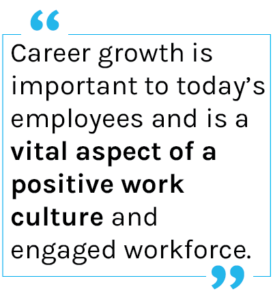Employee retention should be a top priority for colleges and universities today.
Many institutions today are facing the “big quit,” just like countless other organizations,. Turnover is costly and can negatively impact performance, and with a highly competitive hiring market, it’s more important than ever to keep the employees you have. However, there are unique challenges when it comes to employee retention in higher education. Turnover for HigherEd employees spiked during and after the pandemic, often attributed to burnout and disengagement among faculty and staff. Read on for some HigherEd-specific strategies tackle staff and faculty burnout, reduce turnover, and increase retention.
Culture of support
One of the top contributors to faculty burnout has been professors feeling unsupported by their institutions. Workloads have increased, but compensation has not. Faculty reported feeling “disappointed in the institution’s lack of understanding of this added work,” while others said they felt “exploited” because of the additional uncompensated work required to pivot to new teaching methods.
To tackle this challenge, colleges and universities need to think carefully about how to demonstrate their support for faculty and staff as they face reduced budgets and increased workload. Some strategies include:
- Offering flexibility and autonomy to HigherEd employees
- Make expectations for service work clear—many faculty members don’t have a good sense of how much service they need to commit to, making it difficult to say no
- Ensure faculty workloads are balanced—manual faculty reporting systems and manual teaching assignments processes mean that it’s almost impossible to keep track of faculty workload and ensure that no one is over-burdened. Digitize these systems to make ensure transparency and make faculty feel supported.
Engagement and development
 In an Inside Higher Ed podcast, Kevin McClure, associate professor of higher education at the University of North Carolina at Wilmington, noted, “[T]hese are institutions or organizations that ostensibly…are dedicated to human growth and learning and equity. And as a consequence of that, you may have a set of workers or employers or employees who expect from these organizations something different than what they have experienced.”
In an Inside Higher Ed podcast, Kevin McClure, associate professor of higher education at the University of North Carolina at Wilmington, noted, “[T]hese are institutions or organizations that ostensibly…are dedicated to human growth and learning and equity. And as a consequence of that, you may have a set of workers or employers or employees who expect from these organizations something different than what they have experienced.”
Opportunities for professional learning, development, and growth can shift this sense of disengagement for employees at HigherEd institutions. Career growth is important to today’s employees and is a vital aspect of a positive work culture and engaged workforce. Encourage professional development through goal-setting performance management processes, or by providing mentors for younger employees to navigate their career paths and the unique challenges of working in HigherEd.
Compensation and benefits
Another challenge that has driven burnout and disengagement among HigherEd employees is salary. In Inside Higher Ed, McClure noted:
“We’ve had for a long period of time some issues connected to inadequate pay within higher education… salaries have often not been able to keep up with the cost of living increases.”
HigherEd has historically not struggled to hire, despite the lower salaries offered, because institutions have been able to lean on benefits like working for mission-driven organizations or the opportunity for tenure. However, as McClure says, “we cannot rest on this notion of job benefits that is decades old.” Colleges and universities need to revisit what they have historically offered as benefits and ensure that salaries are competitive with other institutions and industries. When examining the benefits that your institution highlights for employees, make sure that the campus is truly fulfilling them—do you advertise a commitment to DEI? A commitment to student success? Growth and learning? Make sure that you can point to the on-campus initiatives that are working towards those goals so employees can feel that the institution is living up to the benefits it claims. Be sure to also implement more tangible benefits that employees today value, like flexible working hours and career growth opportunities.
Make sure that you can point to the on-campus initiatives that are working towards those goals so employees can feel that the institution is living up to the benefits it claims. Be sure to also implement more tangible benefits that employees today value, like flexible working hours and career growth opportunities.
Final thoughts
Employee retention in higher education will continue to be a necessary focus as staff and faculty burnout persists. Work-life balance is still at the center of the burnout conversation, and hiring challenges are not fading. If you’re interested in implementing any of the above strategies at your institution, reach out to PeopleAdmin experts to learn more about the tools that can support your team.